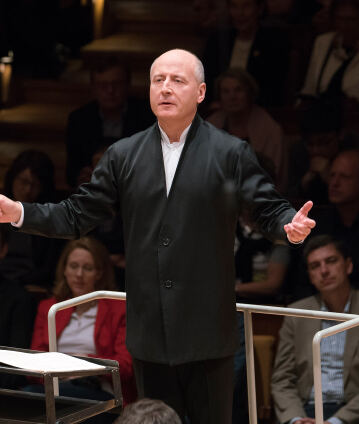Paavo Järvi conducts Brahms and Lutosławski

Witold Lutosławski’s captivating Concerto for Orchestra combines the acerbic power of traditional Polish folk music with ingenious, pioneering construction. A charming contrast is formed by Johannes Brahms’s joyous Second Symphony, written during a holiday at the Wörthersee in which, according to the composer, “The melodies fly so thick here that you have to be careful not to step on one”. The conductor for this concert is Paavo Järvi.
As Witold Lutosławski once confessed, he only wrote “music I like to listen to myself”. Not an unusual statement for a composer of the 20th century, one might say – and yet one that may, in a nutshell, explain the success of Lutosławski’s music. For although the trained mathematician’s multi-layered and differentiated scores are characterised by a high degree of tonal and rhythmic construction, they found – and find – not only admiring recognition among music professionals but also, unusually, great popularity with audiences. Quite understandably, Lutosławski employed different compositional techniques including experimental music – although never for its own sake – but always kept the listening experience in mind. In his Concerto for Orchestra, written between 1950 and 1954, Lutosławski combined typical elements of Polish folk music with his very own compositional language. A clever move! For many of the passages that appear avant-garde on hearing the work for the first time turn out to be adaptations of centuries-old musical traditions.
The Estonian conductor Paavo Järvi pairs this masterpiece by Lutosławski, which according to its composer managed to preserve his “freshness” over the decades, with Johannes Brahms’s Second Symphony, first performed in Vienna in 1877. This symphony came easily to its creator (especially in comparison to its predecessor which took more than twelve years to write). After starting the work during a holiday at Pörtschach am Wörthersee in the summer months of 1877 – described by Brahms as “an unspoiled landscape where melodies fly so thick that you have to be careful not to step on them” – he managed to complete work on the score as early as the October of the same year. Brahms’s Second is probably still his most played symphony, not least because of its cheerful mood. Brahms told his publisher, however, with his own cryptic sense of humour: “The new symphony is so melancholy that you will not be able to bear it. I have never written anything so sad, and the score must come out in mourning.”
© 2018 Berlin Phil Media GmbH
Related interviews
Artists
Our recommendations
- Paavo Järvi and Seong-Jin Cho
- Paavo Järvi and Emmanuel Pahud
- 2018 Europakonzert from Bayreuth with Paavo Järvi and Eva-Maria Westbroek
- Paavo Järvi and Igor Levit perform Beethoven’s Piano Concerto No. 5
- Yuja Wang’s debut with the Berliner Philharmoniker
- Paavo Järvi conducts Beethoven and a world premiere